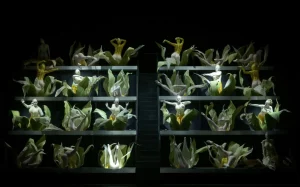
Opéra National de Paris 2021-22 Review: Wagner’s Parsifal
Simone Young’s Conducting Elevates Richard Jones Production at Bastille
By Ching Chang(Credit: Vincent Pontet / ONP)
The week Rafael Nadal lifted his trophy for an unprecedented 14th victory at the Roland Garros tennis tournament in Paris, the opera public attending Richard Wagner’s “Parsifal” at the Opéra National de Paris at the Bastille saw tenor Simon O’Neill triumphantly raise a supersized Holy Grail chalice with a shape that had an uncanny resemblance to the prestigious tournament’s Coupe des Mousquetaires trophy.
The production by British director Richard Jones was led with brilliant incisiveness by Simone Young, with a cast that included, in addition to O’Neill, the Russian soprano Marina Prudenskaya as Kundry, bass-baritones Markus Marquardt as Amfortas, Kwangchul Youn as Gurnemanz, Falk Struckmann as Klingsor, and Reinhard Hagen as Titurel.
Cynical Questioning
While the elegant sporting event at Roland Garros may still be predominantly guided by cherished and mostly unchallenged traditions, these simply no longer carry the same weight or importance in the world of opera as they once did as far as Wagner operas, particularly when it comes to the current treatments of important new stage productions. Especially in Europe, one can affirm without reserves that it is now a hegemonic practice to incorporate some form conceptual deconstruction of the arcane Wagnerian universe in the new stagings of his operas, and everything must be cynically questioned: the myths, magic, the manipulative morality parables, or facile messages served in period props of intensified romanticism.
Stagings are now necessarily injected with a healthy, almost mandatory dose of irreverence and skepticism, occasionally stretched even beyond breaking point into outright ridiculousness, when you set the almost unattainable pompous sense of Wagnerian gravitas against the sheer lunacy and hypocrisy of what the composer will place in front of his audience. All of this process is only made artistically relevant, of course, because it comes bathed in the soundtrack of Wagner’s luminous, luxuriant music of sweeping grandeur and irresistible beauty, the part of the equation that seems to be most resistant against supposed violations of what many observers innocently claim to be “the composer’s intention.”
With its impenetrable layers of Christian symbolism, esoteric rituals, characters representing personified analogies, and the all important McGuffin of all McGuffins —the actual Holy Grail, a new production of Parsifal is a ripe candidate for just this sort of stage vivisection, guts and all, and that is precisely what British director Richard Jones attempts to do. Articles by the production team provided in the performance’s accompanying audience booklet discuss various aspects of what the director attempts to codify in this setting of this Parsifal: Wagner’s peculiar articulation about being an ethical moral being, and yet seemingly having a morality that is ultimately quite “flexible” and adaptive to the circumstances at hand, extending to his repugnant beliefs in racial supremacy, or his cultish sort of advocacy for veganism.
The villainous Klingsor, for instance, has been made by Jones into a geneticist, who cultivates hypersexualized women as greenhouse experiment, who then blossom into the seductive flower maidens that attempt to seduce the foolish Parsifal, with their sensuous oversized breasts, exposed in simulated nudity. Also referenced in the staging is Nazi Germany’s Lebensborn program attempting to create a caste of racially pure Aryan individuals, hinted at with the cultish lodge membership of the Knights of the Holy Grail, wearing gray training uniforms topped by a striking dark tunic perhaps worthy of some random episode on the Star Trek series.
Jones’ staging does manage to examine what one might find disturbing about Wagner’s world view, but the production is perhaps too self-aware and too clever for its own good, as it tries too hard without delivering an intense emotional punch in the way one often sees, for instance, in the stagings of another revisionist, the American director Peter Sellars. Jones did create a few visually arresting tableaus (aided by the excellent lighting design of Mimi Jordan Sherin), yet visually much of it just seemed to evoke an ambiguous feeling of urban mundanity, much like the meeting lounges of a 3-star hotel filled with furniture purchased from industrial catalogs.
Elevating the Show
Yet, Australian conductor Simone Young at the pit successfully elevated the whole enterprise, leading a brilliant reading of Wagner’s most delicate and intricate score that was both musically respectful of the composer and highly original with her own imprint. She tastefully avoided the head first dives of explosive Wagnerian platitudes, choosing instead a pace and flow that felt organic and never overbearing. The textural clarity achieved was comforting and reassuring, and wind instruments in particular were able to shine in the simplicity of the ample five-note musical motivic cell Lutheran church goers will readily recognize as the “Dresden Amen.” She allowed the magical time stopping effects of this music to provide precious moments of soothing contemplation.
Young is gifted a conductor with a vast experience in the composer’s repertoire, and while she did not have perhaps the most beautiful Wagnerian voices available at her disposal in this instance, she made it all work because this was a committed ensemble cast of veteran singing actors.
Leading in the title was tenor Simon O’Neill as the pure fool (looking every bit like a modern version of Frodo Baggins, dressed in below the knee shorts and sloppy wash-n-wear attire), and he made up for what the voice lacked in lush lyricism or power with a characterization of commitment and sincerity.
In the performance I attended, Amfortas was was sung by German bass-baritone Markus Marquardt, a singing actor of obvious excellence. Marquardt took over the remaining of the performances in this Paris Opera run after the originally scheduled Brian Mulligan withdrew for health reasons, and delivered a gripping and at times mesmerizing characterization of the wounded King of the knights.
As Kundry, Russian soprano Marina Prudenskaya offered a chameleonic performance, traversing the metamorphic assumptions of her character with satisfying verve and incisive vocalism. South Korean baritone Kwangchul Youn offered the most polished and well schooled vocalism on stage, with his Gurnemanz attired in a royal blue coaching jump suit, while producing rich, seamless Italianate sound.
A house announcement was made on behalf of Falk Struckmann, indicating that the German bass-baritone would be performing the role of Klingsor though feeling in compromised in health. An experienced veteran at Bayreuth, whatever afflictions affecting the singer were well concealed and barely noticeable in his potent portrayal of the scheming and malevolous Klingsor. German bass Reinhard Hagen delivered on a poignant and dignified rendering of the old Titurel, at times both demanding and pleading. Yet, the most extraordinary element in the whole enterprise may well have been the superb Paris Opera chorus, masterly prepared by Taiwanese chorus director Ching-Lien Wu. Whether in the expansive “Wein und Brot” or the entrance and assembly of the Knights of the Grail, the ensemble delivered Wagner’s soaring and multifaceted choral writing with luminous excellence, capable of turning both the generous brilliance of massed sound or the touchingly subdued introspections into phrased musical statements of culmination.



